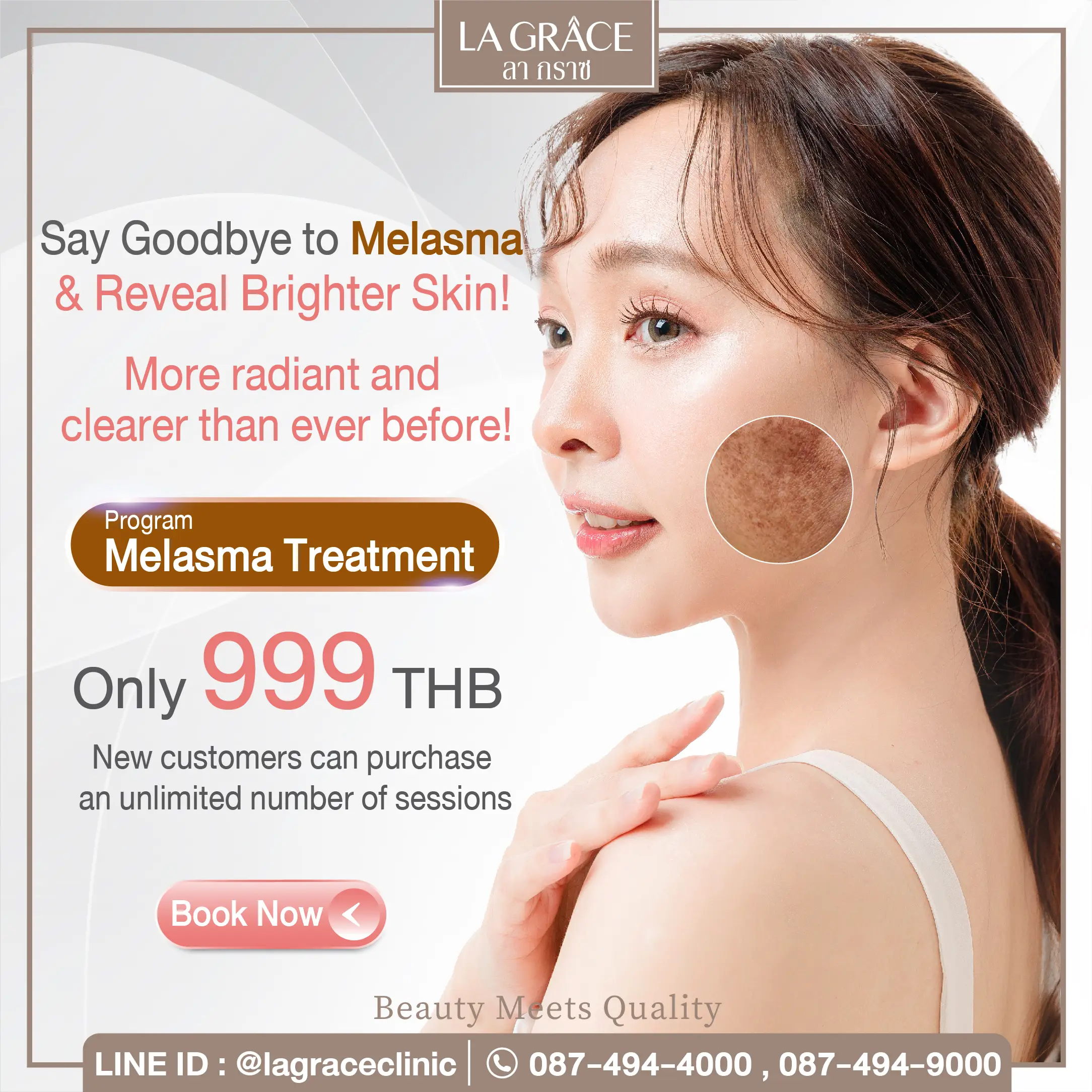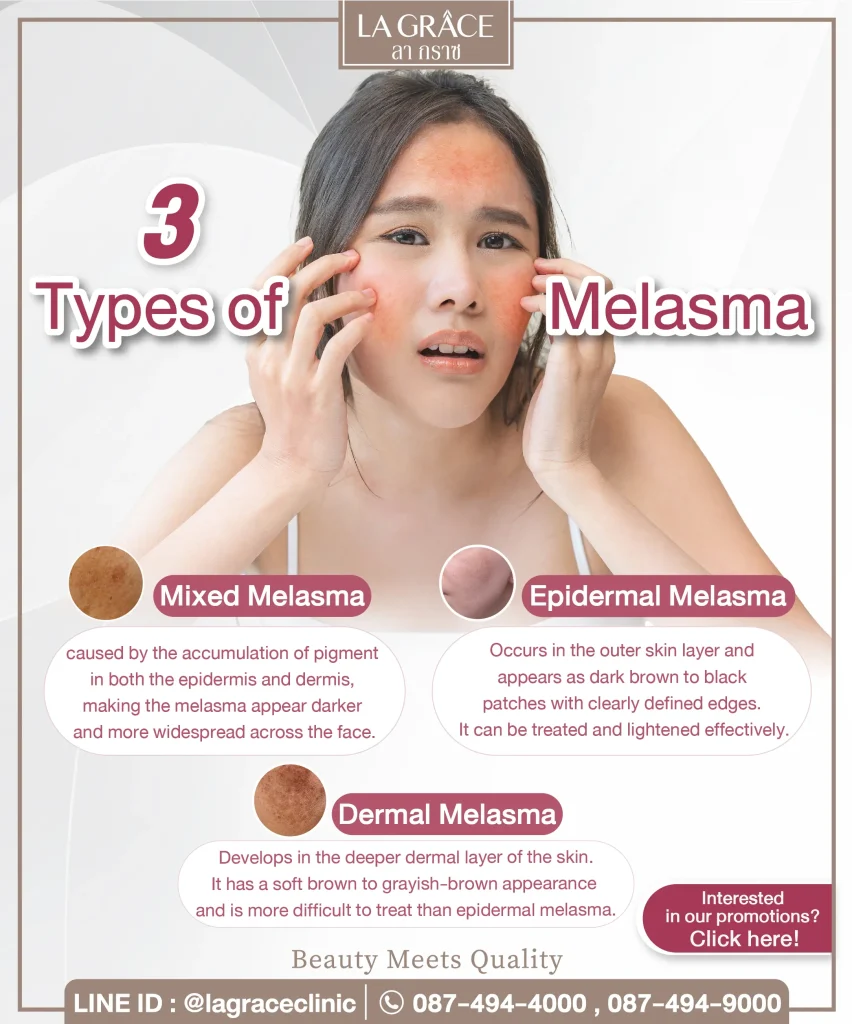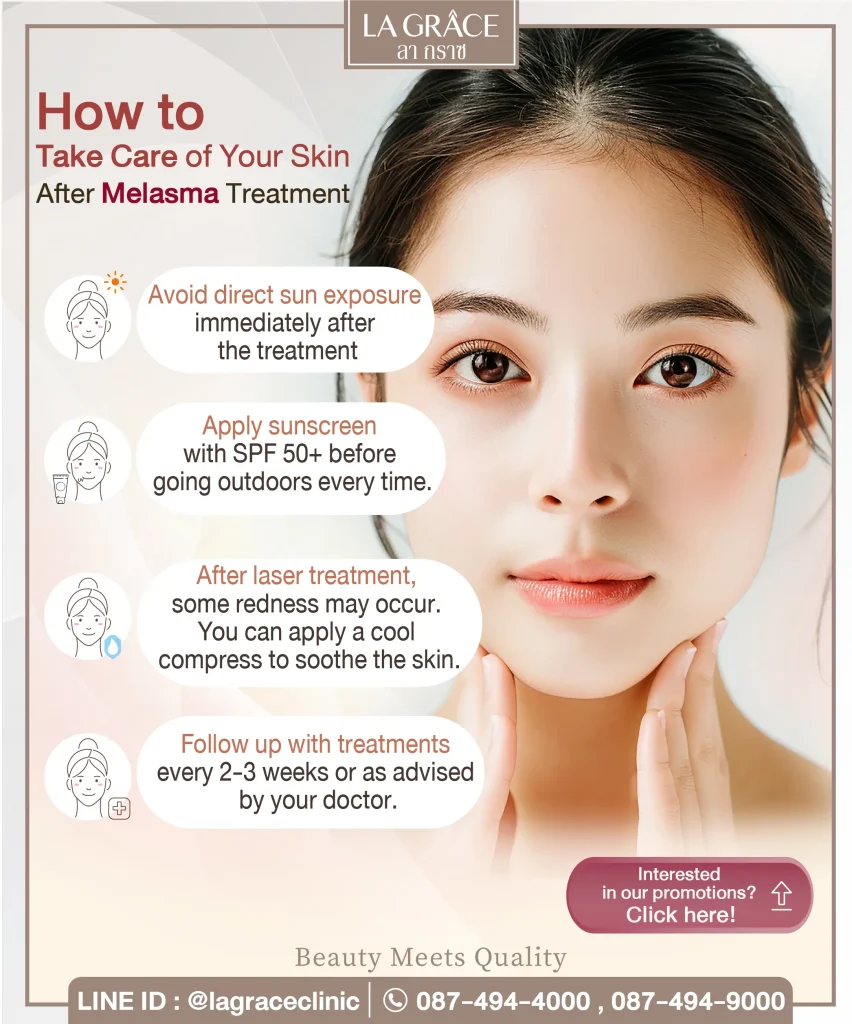Melasma Treatment


Restore Your Radiant Skin for Only 999 THB Per Session!
What is Melasma?
Melasma is a common skin condition characterized by dark patches on the skin, particularly on the face. It most often appears on areas exposed to sunlight, such as the cheeks, forehead, nose, and chin. This condition is more prevalent in women, especially during their reproductive years, including pregnancy and while using birth control pills. Melasma develops due to hormonal stimulation combined with sun exposure, leading to increased melanin production in the skin.
Causes of Melasma
Melasma occurs due to various factors, including:
- Sun Exposure – The primary cause of melasma. UV rays stimulate melanin production as a protective response, but excessive sun exposure leads to melanin accumulation, resulting in dark patches.
- Hormonal Changes – Hormonal fluctuations, such as those during pregnancy (often called the “pregnancy mask”) or due to birth control pills, can trigger melasma.
- Genetics – If a family member has melasma, you may be at a higher risk of developing it.
- Medications – Certain medications, including hormonal treatments and drugs that increase skin sensitivity to sunlight, can contribute to melasma.
- Environmental Factors – Pollution and chemical exposure can also trigger or worsen melasma.
Types of Melasma
Melasma can be categorized based on the distribution of pigmentation on the skin. Each type has distinct characteristics and requires specific treatments.
1. Malar Melasma (Cheek Melasma)
- Appears on both cheeks, extending from the nose to the cheekbones.
- Common in women experiencing hormonal changes, such as pregnancy or birth control use.
Treatment:
- Topical Creams: Containing hydroquinone or azelaic acid to reduce pigment accumulation.
- Laser Therapy: Q-Switched or PicoSure lasers to break down pigmentation.
- Chemical Peels: Helps exfoliate skin and reduce melanin accumulation.
2. Perioral Melasma (Above the Upper Lip)
- Occurs around the upper lip and may spread to the chin.
- Often linked to hormonal fluctuations and birth control use.
Treatment:
- Vitamin C or Retinoid Creams: Inhibits melanin production and promotes skin renewal.
- Fractional Laser Therapy: Stimulates skin regeneration and reduces melasma.
- IPL (Intense Pulsed Light): Reduces pigmentation and brightens the skin.
3. Frontal Melasma (Forehead Melasma)
- Appears in the center of the forehead or near the eyebrows, leading to uneven skin tone.
Treatment:
- High-SPF Sunscreen (SPF 30+): Prevents further pigmentation.
- Fractional Laser Therapy: Removes accumulated pigmentation.
- Chemical Peels: Uses AHA acids to promote skin renewal.
4. Reticular Melasma (Small Spot Melasma)
- Common in individuals with sensitive skin.
- Appears as small, well-defined dark spots on the forehead, cheeks, or nose.
Treatment:
- Glycolic Acid Creams: Promotes exfoliation and reduces pigmentation.
- Q-Switched or PicoSure Laser: Removes melanin deposits.
- IPL Therapy: Enhances skin clarity and reduces pigmentation.
5. Chloasma (Pregnancy Mask)
- Develops during pregnancy due to hormonal changes, causing dark patches on the cheeks, forehead, and upper lip.
Treatment:
- Hydroquinone or Azelaic Acid Creams: Suppress melanin production.
- Fractional or PicoSure Laser: Suitable for postpartum melasma treatment.
- IPL Therapy: Brightens skin and reduces pigmentation.
Melasma Classifications Based on Depth
Melasma is also categorized based on the depth of melanin deposition:
1. Dermal Melasma (Deep Melasma)
- Characterized by dark gray or deep brown patches due to melanin accumulation in the dermis.
- Common in people with darker skin tones and prolonged sun exposure.
Common Areas Affected:
✔ Cheeks: The most common site due to frequent sun exposure.
✔ Forehead: Often affected by UV exposure and skincare products.
✔ Upper Lip: Can be triggered by sun exposure and environmental factors.
✔ Temples: Frequently exposed to sunlight.
Treatment:
- Topical Creams: Containing hydroquinone, retinoids, or azelaic acid to suppress melanin production.
- Q-Switched or PicoSure Laser: Breaks down deep pigmentation and promotes new skin cell formation.
- Chemical Peels: Uses AHA or glycolic acid to exfoliate and fade pigmentation.
2. Epidermal Melasma (Superficial Melasma)
- Results from melanin accumulation in the epidermis, appearing as brown or light brown patches.
- Easier to treat than dermal melasma.
3. Mixed Melasma
Mixed melasma is caused by the accumulation of pigment in both the epidermis and dermis, making the melasma appear darker and more widespread across the face. This type of melasma is more complex and harder to treat compared to superficial and deep melasma.
Mixed melasma occurs due to the accumulation of pigment in both the outer skin layer (epidermis) and the deeper skin layer (dermis). This makes the condition more challenging to treat as pigmentation is dispersed throughout both shallow and deep layers of the skin. It often appears in areas frequently exposed to sunlight and typically presents as alternating dark brown patches.
Common Areas Affected by Mixed Melasma:
- Cheeks: The most common area for mixed melasma due to frequent sun exposure. Pigmentation can be present in both shallow and deep layers, resulting in multi-toned discoloration.
- Forehead: A high-risk area for mixed melasma, especially in individuals with prolonged sun exposure, leading to pigmentation buildup in both layers of the skin.
- Upper Lip: Frequently affected due to sun exposure and hormonal changes, such as pregnancy or the use of birth control pills.
- Temples: Affected due to directional sunlight exposure, causing pigment accumulation in both the superficial and deep layers of the skin.
Mixed melasma is more challenging to treat because of its dual-layer pigmentation, requiring a combination of treatments such as laser therapy, topical depigmenting creams, and skin renewal technologies.
Treatment Methods for Mixed Melasma
- Topical Creams:
- Creams containing hydroquinone, vitamin C, or retinoids help reduce pigment production and improve treatment effectiveness.
- Laser Treatment:
- PicoSure or Q-Switched lasers break down pigment in both the epidermis and dermis, helping to lighten melasma.
- Chemical Peels:
- AHA or glycolic acid peels help exfoliate the skin and reduce pigment buildup in both superficial and deep layers.
- IPL Therapy (Intense Pulsed Light):
- Reduces pigmentation while stimulating collagen production, leading to a more even skin tone.

Preventing Melasma
Preventing melasma involves avoiding key risk factors:
- Daily Sunscreen Use: A high SPF sunscreen (SPF 30 or higher) protects the skin from UV-induced melasma.
- Wearing Hats and Sunglasses: Reduces direct sun exposure on the face.
- Avoiding Hormonal Medications: If possible, limit long-term use of birth control pills or hormone therapy.
- Keeping Skin Hydrated: Using moisturizers helps maintain skin health and reduces the risk of melasma.
Melasma Treatment Options
There are various treatment methods for melasma, including medications and advanced technologies that help reduce pigmentation and even out skin tone:
1. Topical Treatments
Depigmenting creams with active ingredients can effectively treat melasma:
- Hydroquinone: Inhibits melanin production, the main cause of melasma.
- Retinoids: Promote skin cell turnover and reduce pigment buildup.
- Vitamin C: Helps suppress melanin production while boosting collagen synthesis.
- Azelaic Acid: Reduces pigment production and also helps treat acne, which can occur alongside melasma.
These creams must be used consistently, combined with sun protection to prevent recurrence.
2. Laser Treatment
Laser therapy is a popular melasma treatment that uses light energy to break down pigment in the skin. Types of laser treatments include:
- Fractional Laser: Stimulates skin renewal by targeting small sections of skin, reducing pigmentation.
- Q-Switched Laser: High-energy pulses break down pigment deposits in the skin.
- PicoSure Laser: Works at ultra-fast speeds to destroy melanin without damaging surrounding skin.
Laser treatments provide visible results over multiple sessions, depending on the depth of the melasma.
3. Chemical Peels
Chemical peels, using Alpha Hydroxy Acids (AHAs) or glycolic acid, help remove dead skin cells and reduce pigment buildup. This process encourages the growth of new, brighter skin, helping to fade melasma.
4. IPL Therapy (Intense Pulsed Light)
IPL therapy uses multiple wavelengths of light to break down pigment, leading to a more even complexion while stimulating collagen production.
5. Injectable Melasma Treatments (Vitamin C or Glutathione)
Injectable treatments such as Vitamin C or glutathione can help brighten the skin and reduce pigmentation.
- Vitamin C: Reduces melanin production and promotes brighter skin.
- Glutathione: Helps lighten skin tone and reduce inflammation, which can contribute to melasma.
Skincare for Melasma-Prone Skin
- Use High SPF Sunscreen Daily: Sunscreen is essential to prevent melasma from worsening during treatment.
- Choose Gentle Skincare Products: Avoid harsh chemicals that could irritate the skin.
- Avoid Scrubbing or Over-Exfoliating: Harsh scrubbing can worsen melasma.

Conclusion
Melasma is a common skin condition caused by various factors, but it can be effectively prevented and treated. Regular sunscreen use, sun avoidance, and targeted treatments like lasers, topical creams, and chemical peels can help fade melasma and prevent recurrence. With the right skincare routine, you can maintain clearer, more even-toned skin in the long run.
Line: @lagraceclinic
